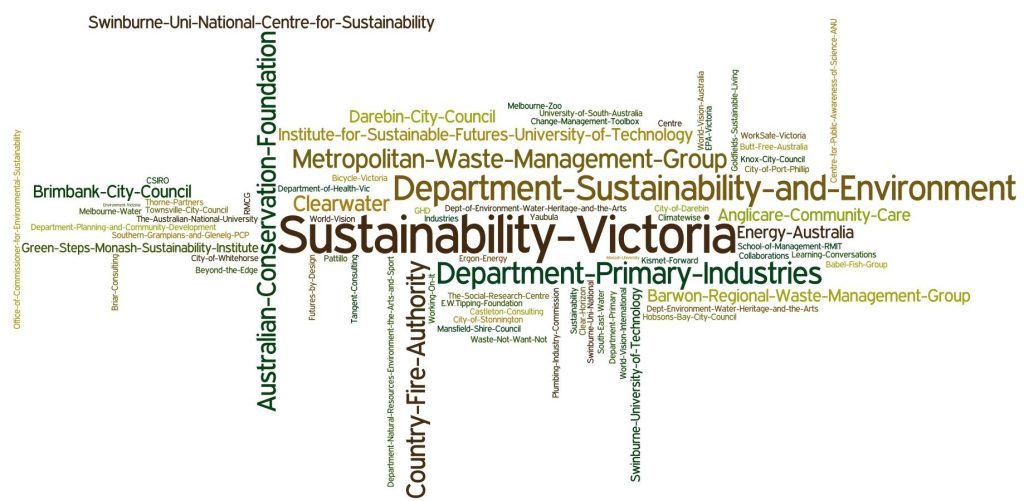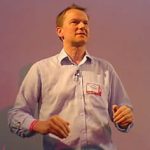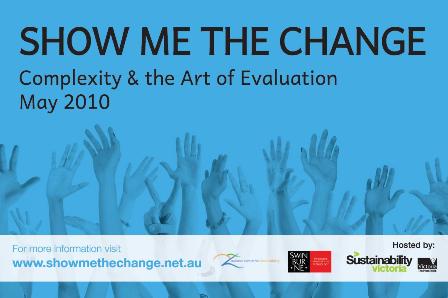The purpose of the case study is to chart an NGOs journey (Mission Australia Queensland) towards sustainability with the aim of encouraging other NGOs to begin their own journey.
The case study illustrates that becoming more sustainable is rewarding. However, it also illustrates that considerable effort is required by the organisation and that the process is sometimes far from straight forward.
As a consequence of process learnings acquired, a number of traits and practices were suggested as being useful.
By raising awareness about the nature of the journey it is hoped that NGOs will be better equipped for the undertaking.
Archive for April, 2010
Journeying Towards Sustainability: An Australian Non-Government Organisation's Experience
Wednesday, April 28th, 2010Between Memory and Experience
Tuesday, April 20th, 2010I recently watched this TED Talk by Daniel Kahneman – he won the Nobel Prize in Economics for his pioneering work in behavioral economics.
The key takeaway for me was the disconnect between ‘experience’ and ‘memory’. This got me thinking about all sorts of contexts, from own happiness to the implications for evaluating behaviour change. At the TED website they describe his presentation as …
“Using examples from vacations to colonoscopies, Nobel laureate and founder of behavioral economics Daniel Kahneman reveals how our “experiencing selves” and our “remembering selves” perceive happiness differently. This new insight has profound implications for economics, public policy — and our own self-awareness.“
After I watched the presentation, I sat down to write this blog post and struggled to document what I was thinking. This post was destined to live a long life in the ‘draft’ folder … then I emailed the link to Irene Guijt (Evaluation Revisited Conference) … who passed it onto Dave Snowden (Cognitive Edge) … and then Dave wrote this post – Between Memory & Experience. Dave writes …
“Seeing the future as anticipated memories is an interesting side idea from the talk. Now there is nothing new here (although its well presented) but its an important reminder in relationship to issues of narrative research.”
Here’s the video – see what connections you can make between the findings and the real world.
I recently watched this TED Talk by Daniel Kahneman – he won the Nobel Prize in Economics for his pioneering work in behavioral economics.
The key takeaway for me was the disconnect between ‘experience’ and ‘memory’. This got me thinking about all sorts of contexts, from own happiness to the implications for evaluating behaviour change. At the TED website they describe his presentation as …
“Using examples from vacations to colonoscopies, Nobel laureate and founder of behavioral economics Daniel Kahneman reveals how our “experiencing selves” and our “remembering selves” perceive happiness differently. This new insight has profound implications for economics, public policy — and our own self-awareness.“
After I watched the presentation, I sat down to write this blog post and struggled to document what I was thinking. This post was destined to live a long life in the ‘draft’ folder … then I emailed the link to Irene Guijt (Evaluation Revisited Conference) … who passed it onto Dave Snowden (Cognitive Edge) … and then Dave wrote this post – Between Memory & Experience. Dave writes …
“Seeing the future as anticipated memories is an interesting side idea from the talk. Now there is nothing new here (although its well presented) but its an important reminder in relationship to issues of narrative research.”
Here’s the video – see what connections you can make between the findings and the real world.
I recently watched this TED Talk by Daniel Kahneman – he won the Nobel Prize in Economics for his pioneering work in behavioral economics.
The key takeaway for me was the disconnect between ‘experience’ and ‘memory’. This got me thinking about all sorts of contexts, from own happiness to the implications for evaluating behaviour change. At the TED website they describe his presentation as …
“Using examples from vacations to colonoscopies, Nobel laureate and founder of behavioral economics Daniel Kahneman reveals how our “experiencing selves” and our “remembering selves” perceive happiness differently. This new insight has profound implications for economics, public policy — and our own self-awareness.“
After I watched the presentation, I sat down to write this blog post and struggled to document what I was thinking. This post was destined to live a long life in the ‘draft’ folder … then I emailed the link to Irene Guijt (Evaluation Revisited Conference) … who passed it onto Dave Snowden (Cognitive Edge) … and then Dave wrote this post – Between Memory & Experience. Dave writes …
“Seeing the future as anticipated memories is an interesting side idea from the talk. Now there is nothing new here (although its well presented) but its an important reminder in relationship to issues of narrative research.”
Here’s the video – see what connections you can make between the findings and the real world.
Adapting sustainability accounting inventions to show local communities the change
Monday, April 19th, 2010Showing national governments change in their jurisdictions toward, or away from, a sustainable development path dominates invention and innovation in sustainability accounting. Helping sub-national governments do the same is rarely considered by accounting scholars.
When a nation’s per capita wealth is not declining over time is accepted as by many as a reflecting a national government’s success in guiding transition to a state of sustainability. Acceptance is based on three main arguments: economic theory, common sense, and simplified decision-making. The World Bank leads inventions in estimating change in a nation’s wealth, using a portfolio of five stocks: natural, produced, human, social, and governance capital.
A pro bono project adapted the World Bank model to assess change in a local community’s capital stocks through two phases during 2005-08. Change in natural, produced, and human capital stocks of the Campaspe community were assessed during 2005, using ABS small area statistics as quantitative indicators. Senior management in its Council then assessed qualitative change in the same indicators. Change in social and governance capital stocks of the Eurobodalla community were assessed during 2008, by combining a social network analysis tool with content analysis of Council’s Annual Reports and Community Services Directories.
Who's coming … so far
Saturday, April 17th, 2010With a fortnight to go, here’s a visual-snapshot of the organisations, departments and groups are coming to share their wisdom at Show Me The Change.
The bigger the name appears … the bigger the number coming from that Tribe.
With only 2 weeks left to register, who else could be on this list. Who else can you invite along from within your own networks?

For a full list of people and groups visit this page.
Cheers, Geoff Brown
Post Conference Tyranny Busting!
Thursday, April 15th, 2010In the organisational world, there is a prevailing idea that change is difficult and stressful, and that innovation is scarce and requires effortful management to succeed. Overlay evaluation and is it any wonder we get stuck? 
We’re going to explore how this is reflected in three tyrannies:
- The tyranny of the explicit and the fear of not knowing.
- The tyranny of excellence and the fear of not being good enough.
- The tyranny of effort and the fear of failure.
Once you can recognise these tyrannies and the effects they have on how we work, the next step is to bust them. We’re planning to explore these tyrannies and highlight some ways to bust them with a series of practical and impractical exercises. We’re going to reveal our own prejudices about facilitating change and innovation, which emphasize letting go of the effort to be spectacular in favour of being open to surprise and attentive to small ideas instead of chasing grandiose visions.
These are based on years of wrinkle-inducing experience, and in particular our shared interests in Open Space, improvisation and creativity. With a special nod to Keith Sawyer’s recent book, Group Genius. Keith says, among other things, that “virtually all of the conventional wisdom on creativity and innovation is false”. That has a few implications for behaviour change programs, we think.
Exactly what will happen depends, as always, on who turns up. We can promise a range of verbal, physical (but not difficult), meditative, reflective, amusing and extraordinary activities all designed to help you notice more.
If you go on to use all this to help yourself and others to be more creative, more fulfilled, more beautiful, thinner, richer, healthier, then we’ll be delighted for you. But no pressure.
Oh, and we think this also might help in our understanding of complexity and behaviour change, and even evaluation.
This post-conference workshop will be hosted by Johnnie Moore (UK) and Viv McWaters (Australia).
 Johnnie Moore started his career as a speechwriter to Lord Sainsbury before working in advertising. After many years of successfully dressing mutton up as lamb, he became a facilitator working for a wildly varied array of clients from big fat corporates to small charities and all shades of organisation inbetween. He has worked with clients such as Johnson & Johnson, National Public Radio, O2, PwC, The Clore Leadership Programme, NESTA, American Express, the BBC and Channel 4.
Johnnie Moore started his career as a speechwriter to Lord Sainsbury before working in advertising. After many years of successfully dressing mutton up as lamb, he became a facilitator working for a wildly varied array of clients from big fat corporates to small charities and all shades of organisation inbetween. He has worked with clients such as Johnson & Johnson, National Public Radio, O2, PwC, The Clore Leadership Programme, NESTA, American Express, the BBC and Channel 4.
Viv McWaters has dabbled in journalism, community education, science and improvisation, which makes an ideal platform for her current career as a facilitator.She works with people to tap into their creativity and leadership potential, and has worked in places as diverse as Armenia and Zambia.
Register here for this post conference workshop.
Social Learning through evaluation of catchment demonstration programs for salinity management
Wednesday, April 14th, 2010This project shows how a social learning approach can be incorporated into evaluating public environmental programs. A social learning approach is particularly suited to complex environmental challenges which are inherently difficult to understand, predict, and manage, thus complicating the evaluation process. The project focuses on an Australian case study of dryland salinity management where there are major knowledge barriers impeding conventional management techniques. The research presented in this paper focused on evaluating a public demonstration program to
track its impact through its design, implementation, and monitoring phases. The project shows that, by incorporating social learning principles and practices, program evaluation can promote collective action, critical reflection, and increased knowledge to underpin improved environmental management
For more information see: Measham (2009) Social Learning Through Evaluation: A Case Study of Overcoming Constraints for Management of Dryland Salinity, Environmental Management Vol 43(6), pp 1096-1107
http://dx.doi.org/10.1007/s00267-008-9265-5
If so much change occurs through word of mouth, how do we evaluate it?
Tuesday, April 13th, 2010There is general agreement that word of mouth marketing is a critical element of changing behaviour. Whether it is a family member, colleague, neighbour, or friend, we are more likely to take on the advice and behaviours that are modelled by those we trust. This is the basis of effective communication (think also of the 6 degrees of separation experiment). Mark Earls, the author of Herd: how to change mass behaviour by harnessing our true nature provides great examples of how social networks are key to changing mass behaviour.
Mark recently posted a blog about how important it is to understand social networks.
Mark notes: Social networks are not channels for advertisers or for the adverts/memes you, your clients or any of your so-called “influentials” create, social networks are for all of the people who participate in the network.
So if word of mouth is an element of your behaviour change program (as it should be), how can you track its spread, and find out whom the key people are in networks? Well, social network analysis is one way! So what is a social network analysis?
Andrew Rixon, from Babelfish Group, notes in an e-booklet on enhancing collaboration that Social Network Analysis is the technique of analysing roles and social networks…. The outcomes of social network analysis provides surprising and insightful results allowing structure(s) to become visible and discussable.
Making such networks visible should surely be one of the goals of evaluation. In this way, for those who have read Gladwell’s Tipping Point, you can find out who the mavens, connectors and salesmen are.
Interested in finding out more on Social Network Analysis?
Andrew Rixon will be holding a post-conference workshop on this very topic, so check out the program of post conference workshops and register online.
What's a circus got to do with evaluation of behaviour change?
Tuesday, April 13th, 2010 We’re having our conference dinner at the National Institute of Circus Arts in Prahran. It’s an amazing space and the circus students will be providing entertainment throughout the night.
We’re having our conference dinner at the National Institute of Circus Arts in Prahran. It’s an amazing space and the circus students will be providing entertainment throughout the night.
The dinner itself is designed to enable continuing conversations and building of relationships. That’s because one of the key principles underpinning Show Me The Change is “conversations first, relationships, then transactions”. Why? Simply because transactions without a foundation of relationship are doomed to failure at worst, compliance at best.
The circus has transformed itself, from the use (and abuse) of animals to modern theatre, that still applies the ancient improvisation of clowning and physical theatre. It’s this transformation that is of interest to us as evaluators of behaviour change in complexity, and the concept of liminal space, that is so well articulated in the trapeze.
I wrote about liminal space here. Here’s a part of that post.
When you’re asking me to change a particular behaviour (even if it’s for my own good, or for the well-being of others, or even the planet) you’re asking me to let go of something familiar and take up something unfamilar. That space between letting go and grabbing on to something new is called liminal space. You’re asking me to enter a space of unknowing, of uncertaintly and of change. Is it any wonder I’m reluctant?
I’m more likely to enter liminal space if I think it’s OK, if I feel safe, and have some idea of what I’ll be grabbing onto. Think of it this way. If you were a trapeze artist, would you let go of the bar if there was no safety net and no-one on the other trapeze to catch you? Or if the trapeze is a bit of a stretch for you, think of monkey bars at the playground. Spend some time watching kids playing on them. There you can see liminal space in action. It’s not possible to make any progress on monkey bars unless you let go of one bar before grabbing hold of the next one. In fact, that’s probably an even better analogy for behavior change, because on the monkey bars, you usually hedge your bets – holding on to the previous bar with one hand while grabbing the next one with the other. Sooner or later though you STILL have to LET GO to progress.
So in our behaviour change programs, what are we asking people to let go of and how are we supporting them in liminal space?
So I’m looking forward to some great conversations and some great entertainment at the circus on Tuesday May 6. How about you? Click here to book for this great dinner.
Viv McWaters
When evaluation reinforces the status quo
Friday, April 9th, 2010I see a lot of similarities between behaviour change interventions for sustainability and international development assistance. Both fields seek to intervene to change participants’ behaviours, and generally this is done through a linear model of cause and effect, where the intervention is evaluated as the sole agent of change. In a recent post on complexity and development, Ben Ramalingam highlights a recent publication by Olivier Serrat, Head of Knowledge Management at the Asian Development Bank:
Development is a complex, adaptive process but—with exceptions—development work has not been conducted as such… development assistance often follows a linear approach to achieving outputs and outcomes……Any planning process is based on assumptions—some will be predictable, others wishful. If the assumptions are based on invalid theories of change (including cause-and-effect relationships) and on inappropriate tools, methods, and approaches derived from those, development agencies jeopardize the impacts they seek to realize.
In terms of evaluation, the risk is not solely that we jeopardise the impacts, but that we choose evaluation methods that will seek out what we want to show, whether this has actually occurred or not. If we are intent on showing a particular change, it is quite easy to (inadvertently or not) seek out what we (want to) believe actually happened, and by doing this we reinforce the perpetuation of behaviour change interventions that may not be all that successful. And in doing this we reinforce the status quo, rather than move towards better practices that account for complexity.
Here’s a nice quote from Aaron Levenstein to keep in mind:
Statistics are like bikinis. What they reveal is suggestive, but what they conceal is vital.
Who else do you want to see at Show me the Change?
Thursday, April 8th, 2010The conference has already attracted a great number of participants from a wide variety of backgrounds. And as this conference is not one where “experts” will be doing all the “talking to you”, the diversity of people will make for passionate and thought-provoking conversations.
If you have already registered, who else do you know who has something to share or someting to learn from this conference? Why not let them know that you’ll be there, and that you would value their participation and exchange of ideas. You can download a conference e-card from here, which you can use to email those whom you think should also attend.
